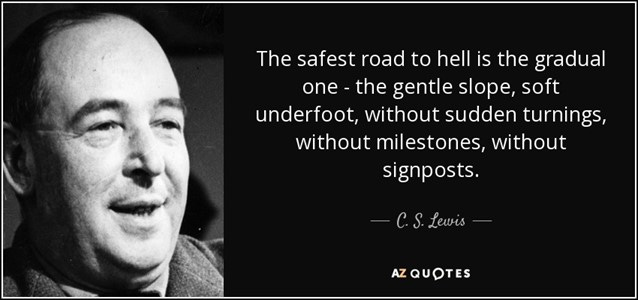Once the Left Gets You to Accept that 2+2=5, It's Over for You
Don’t let the cry-bullies make you say that there are 5 lights
There’s a famous episode of Star Trek: The New Generation called Chain of Command, Part II. In that episode, Captain Jean Luc Picard (played by Patrick Stewart) is captured on a mission in Cardassian territory. A Cardassian by the name of Gul Madred drugs Picard, dehumanizes him, and brutally tortures him for information. However, he also does something else. Madred points out four lights on the wall to Picard and lets him know all the torture can stop and life can be much better if he will only say that there are actually five lights. This is a running theme throughout the episode.
Madred torments Picard over and over while offering to let him off easy if only he will say that there are actually five lights. Eventually, because it’s TV, Picard stays defiant, makes it through the torture, and comes out on top.
It’s easy to understand why the Cardassian would want Picard to give him information that could be used in a military attack, but why was he so determined to get Picard to say that there were 5 lights when there were actually 4? What difference did it ultimately make? Well, what the late, great C.S. Lewis said of Hell is also true of a man’s will, his character, decisions, and self-image:
During the Vietnam War, the Vietnamese used a “brainwashing” technique on some soldiers that was so subtle and brilliantly done that many people probably wouldn’t even consider it to be brainwashing, although it certainly was. They’d bring in a soldier and tell him to write an essay saying something critical about America. Of course, all of us could come up with SOMETHING critical to say, right? Then later, the Vietnamese would make these prisoners READ their essays over the prison camp’s loudspeakers. Naturally, hearing their country criticized by one of their own aggravated their fellow POWs. The Vietnamese artfully played this up by giving the POWs who cooperated better food, nicer accommodations, and better treatment while the other POWs were treated like garbage. Soon, most of the POWS were furious with the ones who cooperated and viewed them as collaborators, while those POWs felt unfairly treated. After all, they didn’t lie, did they? Everything they said was true and if they thought about it, they could come up with even more negative things about America. As this process repeated, cognitive dissonance kicked in and these POWs became ever more positive about Vietnam and negative about their own country.
Incidentally, playing on cognitive dissonance is now a centerpiece of modern American politics. In fact, once you understand cognitive dissonance, you’ll have a much better understanding of why a lot of things are happening. Here’s a little primer to give you a better idea of what it’s all about:
Cognitive dissonance is a theory in social psychology. It refers to the mental conflict that occurs when a person’s behaviors and beliefs do not align.
...Not everyone experiences cognitive dissonance to the same degree. Some people have a higher tolerance for uncertainty and inconsistency and may experience less cognitive dissonance than those who require consistency.
…As people generally have an innate desire to avoid this discomfort, cognitive dissonance has a significant effect on a person’s:
· behaviors
· thoughts
· decisions
· beliefs and attitudes
· mental health
People experiencing cognitive dissonance may notice that they feel:
· anxious
· guilty
· ashamed
As a result, they may:
· try to hide their actions or beliefs from others
· rationalize their actions or choices continuously
· shy away from conversations or debates about specific topics
· avoid learning new information that goes against their existing beliefs
· ignore research, newspaper articles, or doctor’s advice that causes dissonance
Avoiding factual information can allow people to continue maintaining behaviors with which they do not fully agree.
When people tie their self-image to a belief, they will often go to great lengths to avoid doing or thinking anything that can challenge that belief.
Now, getting back to Picard and his lights. Consider the dilemma of liberals today. Their ideas are for the most part disastrous, unworkable, and impossible to adequately defend in any kind of debate. That’s why almost no one is trying to make the case to middle America that rent control actually controls rent, defunding the police will reduce crime, or that letting the homeless crap all over the sidewalk will make life better for everyone else. So, they can’t convince people with reason. Also, in America – at least so far – they can’t use the tactics the Russians and Chinese do to keep people in line. Say the wrong thing today in those countries and the secret police will haul you off to a work camp in the middle of the night.
So, liberals have to keep people in line with the tools they have. Liberals in the mainstream media can lie about you. They can be mean to you online. They can “deplatform” you for saying things they don’t like. If liberals have enough control of an industry, they can “cancel” you and if they don’t, they can try to give the false impression that a relatively small number of people are actually an army to convince a business or a corporation into doing their work for them.
Liberals are not trying to convince anyone their ideas are right; they’re trying to intimidate people into submission.
One of the many ways they do this is to demand that people agree to something that they KNOW is a lie if they don’t want to be labeled a “bad person”:
Rachel Levine is a woman. Lia Thomas is a woman. Pointing out that you can’t change genders leads to suicide, as opposed to trying to change genders leads to suicides. The police are racist and killing large numbers of unarmed black Americans. There’s “scientific consensus” that global warming is manmade. America is “structurally racist.” Republicans hate black people. Disagreeing with Obama was racist. Black Americans aren’t successful as a group because of something white Americans as a group are doing. Republicans hate women. You hate gay Americans if you don’t support gay marriage. Voting against Hillary Clinton was sexist and voting for Donald Trump was racist. Hearing alternate opinions is “violence.” Enforcing immigration laws is “racist.” Wanting to limit immigration is “racist.” Jan 6 was an “insurrection.” Only groups liberals don’t like have “privilege” while groups liberals do like are “disadvantaged.” Law-abiding gun owners having weapons is why we have mass murders. It’s “greedy” to want to keep more of your own money, not “greedy” to want more of other people’s money to be given to you. It’s rude not to use people’s “personal pronouns,” not rude to ask people to use your “personal pronouns.” It’s not unpatriotic to disrespect the flag.
We could go on and on with this, but there is no real intellectual argument behind any of these ideas. It’s: “Anyone who believes these things is evil and racist and probably a Nazi, too. That’s why they deserve to be punished, canceled, and abused at every opportunity.”
If they can get you to go along with something that you absolutely know is a lie, then it makes it that much easier for you to go along with the next lie. Once you’ve already gone against your conscience once to make life easier for yourself, it’s going to be even more tempting to do it the next time you’re in the same situation or the Left goes a little further down the slippery slope. Next thing you know, cognitive dissonance kicks in and you’re DEFENDING things you don’t even believe are true because it’s supposedly the “smart” thing to do.
As a side note, Donald Trump gets a lot of justifiable praise from conservatives for his agenda and a lot of justifiable criticism for his mouth and temperament, but one area he doesn’t get nearly enough credit for is his willingness to cut through all the imaginary lines Republicans decided they couldn’t step over during the past few decades. The GOP accepted so many of the Left’s premises over the years that it made it extremely difficult to pursue a conservative agenda on a lot of issues. Trump simply didn’t give a damn what the precedent or “Washington way” of handling things was. Granted, that bit him in the behind on occasion, but more often than not he made conservatives ask, “Why have so many Republicans been pretending there are 5 lights on this issue when we all know there are four?”
Ultimately, people who want to protect their self-integrity and build a better America for their children need to remember that wonderful quote from Solzhenitsyn:
It’s okay to admit when you’re wrong, say the other side is right if they truly have a good point and you should certainly try to keep an open mind, but don’t be intimidated into compromising what you believe. Have the courage of your convictions. Refuse to say something you know is a lie to make it easier on yourself. There are a lot of things I disagree with J.K. Rowling, Joe Rogan, and Glenn Greenwald about, but their refusal to say 2+2=5 to make the woke happy has genuinely been good for this country. Follow their example, even if it means going against the current. Just as Andrew Jackson said:
We need a lot of things in this country today, but one of the things we need most is more people with the moral courage to speak up when the Left insists 2+2=5.





Excellent essay, John. I get to the point where I have to turn off the TV when the national news comes on over ABC, CBS, or NBC because their narrative journalism precludes them from presenting a balanced news story on just about anything. I'm not trying to encourage your readers to look elsewhere, but let me say that Jason Whitlock had a great show last week called the United States of Lies that started with Lia Thomas and brought in a laundry list of other lies. Like you, he points out how accepting one lie puts you in a position where you join the coalition of liars and can't dare speak out against even the lies you don't like. He reminds us that the Bible is the source of truth, and that's why our demonic progressives attack Christianity so unrelentingly. Thank you for your courage and integrity in informing us about what's going on in America.
"The left". Lol. Such huge overgeneralizations made by you people.
You have to be amazingly ignorant if you think this kind of tactic only applies to, "the left".
Question your own upbringing.